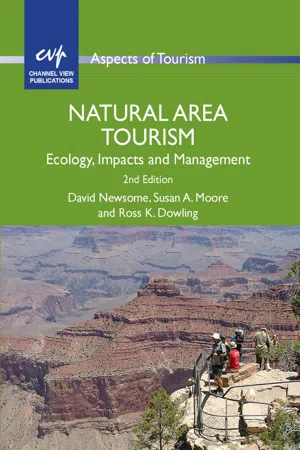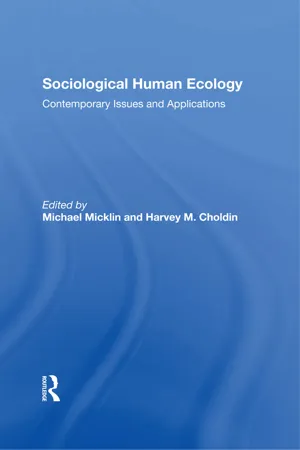Biological Sciences
Ecological Levels of Organization
Ecological levels of organization refer to the hierarchical structure of ecological systems, from individual organisms to the biosphere. These levels include individuals, populations, communities, ecosystems, and the biosphere. Each level interacts with and influences the others, contributing to the overall functioning and stability of the ecosystem. Understanding these levels is crucial for comprehending ecological processes and dynamics.
Written by Perlego with AI-assistance
Related key terms
4 Key excerpts on "Ecological Levels of Organization"
- eBook - ePub
Natural Area Tourism
Ecology, Impacts and Management
- David Newsome, Susan A. Moore, Ross K. Dowling(Authors)
- 2012(Publication Date)
- Channel View Publications(Publisher)
Ecology is concerned with the structure and functioning of ecosystems and thus how plants and animals interact together and with the physical environment. Although most ecosystems are very complex and difficult to study as entire systems, their essential structure and function are well established.Ecosystems comprise structural components such as living organisms (biotic components), soil and landforms and other non-living features (abiotic components), such as wind, rain and water flow. Energy and materials, such as water and nutrients, flow through this combined system, resulting in ecosystem function (Figure 2.2 ).The structure of ecosystems
Ecology can be studied from the perspective of populations or communities of plants and animals or whole ecosystems (Figure 2.1 ). A population refers to the number of organisms of the same species which inhabit a defined area, while a community consists of a group of populations of different species interacting with one another in a defined area. An ecosystem, on the other hand, represents a community of organisms interacting with the environment.The scale at which an ecosystem can be identified ranges from the microbial community inside the gut of a cow through to a pond, ocean, forest or the entire planet. Despite this issue of scale, we can conveniently separate ecosystems into the two major divisions of terrestrial and aquatic (Table 2.1 ). These can then be sub-divided further according to the occurrence of specific plant and animal communities and the differing physical factors that determine their existence. On land, for example, differences in moisture and temperature give rise to different ecosystems in the form of forest, woodlands, grasslands and deserts. These comprise the major terrestrial ‘biomes’, which can be further divided according to specific conditions of precipitation, temperature, the occurrence of fire and differences in soil conditions. An example of this can be seen in the global occurrence of forests, which can be divided into tropical rainforests, tropical seasonal forests, temperate rainforests, temperate forests and northern coniferous forest, or taiga. Despite such differences in detail it is possible to define the structure of any ecosystem according to its major biotic (living) and abiotic (non-living) components (Figure 2.2 - Gabrielle I. Edwards, Cynthia Pfirrmann(Authors)
- 2021(Publication Date)
- Barrons Educational Services(Publisher)
18ECOLOGY
WHAT YOU WILL LEARN
In this chapter, you will explore the interrelationships among living things and the factors in the nonliving environment that affect life. You will also learn how living things can change the environment.SECTIONS IN THIS CHAPTER•The Concept of the Ecosystem•Energy Flow in an Ecosystem•Biogeochemical Cycles•The Limiting Factor Concept•Greenhouse Effect•Global Warming•Ecological Succession•World Biomes•Humans and the Biosphere•Conservation•Review Exercises•Connecting to Life/Job Skills•Chronology of Famous Names in BiologyOVERVIEW
Ecology is the science that studies the interrelationships between living species and their physical environment. The word ecology was coined in 1869 by the German zoologist Ernst Haeckel to emphasize the importance of the environment in which living things function. The environment includes living or biotic factors and nonliving factors, referred to as abiotic factors.The abiotic factors consist of physical and chemical conditions that affect the ability of a given species to live and reproduce in a particular place. Included in the abiotic factors are temperature, light, water, oxygen, pH (acid-base balance) of soil, type of substrate, and the availability of minerals. Certain kinds of plants and animals will flourish in a natural community if the conditions are present that permit their survival. Species interact to influence the survival of one another. One important principle of ecology is that no living organism is independent of other organisms or of the physical environment, if they share the same community.The Concept of the Ecosystem
Certain terms are used in ecology to provide a consistent description of conditions and events. A population refers to all of the members of a given species that live in a particular location. For example, a beech-maple forest will contain a population of maple trees, a population of beech trees, a population of deer, and populations of other species of plants and animals. All of the plant and animal populations living and interacting in a given environment are known as a community- eBook - ePub
Sociological Human Ecology
Contemporary Issues And Applications
- Michael Micklin, Harvey M Choldin(Authors)
- 2019(Publication Date)
- Routledge(Publisher)
It is important to note that as defined here this “effective environment” includes only those external conditions that impinge directly on the behavior of the unit in question rather than all possible external conditions. This limited conception of the environment has sometimes been referred to as the “habitat” of the organism or population (Dice, 1952; Reid, 1962).Nearly any habitat includes a variety of populations, the totality of which make up a community . This community of organisms along with their associated environments constitute an ecosystem: “Any unit that includes all the organisms in a given area interacting with the physical environment so that a flow of energy leads to clearly defined trophic structure, biotic diversity, and material cycles (i.e., exchange of materials between living and nonliving parts) …” (Odum, 1971:8).The ecosystem concept represents the most inclusive unit of analysis in modern ecology. Ecosystems can range in scope from a laboratory culture to a pond, lake, or forest to a watershed, region, or continent. At the most inclusive level, the entire planet can be viewed as a single ecosystem.Any ecosystem is organized in terms of a complex set of relationships. In simplified form, however, ecosystems can be characterized in terms of a continuous flow of materials, energy, and information (Duncan, 1964). Materials follow circular paths, while the flow of energy and information is noncircular. In other words,“Materials are used over and over again…extracted from the environment by some organisms, passed along to other organisms, and returned finally to the environment to become available for a repetition of the cycle… The flow of materials…is accomplished only if work, an expenditure of energy, is done… The ecosystem continually loses potential energy as work is done, with the supply being replenished from the outside…” Energy inputs, in even the simplest living creatures, are dependent upon “… information or ‘instructions’ on how the energy is to be expended…. Information is increasingly recognized as a fundamental economic and technological ‘stuff’ comparable to energy” (Duncan, 1964:37–40). - eBook - ePub
Human Behavior in the Social Environment
Theories for Social Work Practice
- Catherine N. Dulmus, Karen M. Sowers, Bruce A. Thyer(Authors)
- 2012(Publication Date)
- Wiley(Publisher)
Contemporary research and theory in physics and biology suggest that reality is best thought of not as a collection of objects, but as an “inseparable web of relationships” (Capra, 1996, p. 37). The relational components of this web are patterns of transactional events; objects (including organisms) are more like emergent consequences of those transactions, and have reality only within networks of relationships (Esfeld & Lam, 2011). Cells, organisms, and ecosystems are all organized and defined by such network patterns. The hierarchical organization of systems described in GST (subsystems, focal systems, suprasystems) emerges from levels of networks. “Members of an ecological community are interconnected in a vast and intricate network of relationships, the web of life. They derive their essential properties and, in fact, their very existence from their relationships to other things” (Capra, 1996, p. 298). A neighborhood, then, is the relationships among families, residents, businesses, churches, and other elements present within a geographic area, along with their larger context; a family is the relationships among members. This understanding suggests that a tradition “person-in-environment” framework is overly constraining; the person and everything defined as environment exist only as nodes within a single transactional field. The person exists only in those (internal and external) transactions. This is a dramatic epistemological shift, and one with profound implications for practice.The work of social work is action taken to influence those transactional webs of relationship. The social worker is part of the web as is the client, and the work they do together will be supported, opposed, or both by transactions elsewhere in the web. There is a similarity to indigenous thought here as well; from certain Native perspectives, every action taken can be viewed as strengthening or damaging the web of life (or in some cases some of each; Lowery & Mattaini, 2001). As discussed later, understanding the dynamics of that web may have the potential to resolve certain intractable issues with which contemporary social work is struggling.Self-Organizing Systems
Recent systems work has also expanded our understanding of the structure and boundaries of living, self-organizing networks. As Hudson notes:Self-organizing systems represent a recently identified class of phenomenon. Specifically, they represent a type of emergence that involves the apparently spontaneous development of structure in complex systems in response not so much to external conflicts or the struggle for survival but to the internal logic of the interacting subsystems. (2000, p. 554)
Learn about this page
Index pages curate the most relevant extracts from our library of academic textbooks. They’ve been created using an in-house natural language model (NLM), each adding context and meaning to key research topics.



